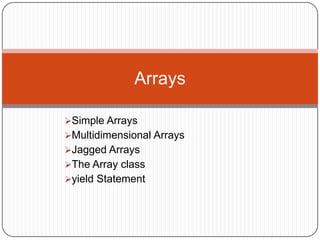
Arrays C#
- 1. Arrays Simple Arrays Multidimensional Arrays Jagged Arrays The Array class yield Statement
- 2. Simple Arrays An array is a data structure that contains a number of elements of the same type. Array Declaration Syntax: datatype[] myArray; Array Initialization Syntax: datatype[] myArray=new datatype[size];// size is a integer value
- 3. Simple Arrays With this declaration and initialization, the variable myArray references four integer values that are allocated on the managed heap.
- 4. Multidimensional Arrays One dimensional arrays are indexed by a single integer, A multidimensional array is indexed by two or more integers. Syntax: datatype[,] twodim=new datatype[size1,size2]; Ex: int [,] twodim={{1,2,3},{4,5,6},{7,8,9}};
- 5. Jagged Arrays A two-dimensional array has a rectangular size(Ex: 3X3). A jagged array is more flexible in sizing the array, With jagged array every row can have different Size.
- 6. Jagged Arrays A jagged array is an array whose elements are arrays. The elements of a jagged array can be of different dimensions and sizes. A jagged array is sometimes called an "array of arrays." Syntax: datatype[][] jagged =new datatype[size][]; Jagged[0]=new datatype[2]{//values}; Jagged[1]=new datatype[6]{//values}; Jagged[2]=new datatype[4]{//values}; ..
- 7. The Array Class Array Class provides methods for creating, manipulating, searching, and sorting arrays, thereby serving as the base class for all arrays in the common language runtime. Declaring an array with brackets is C# notation using Array Class. Creating Array using Array class Array arr1=Array.CreateInstance(typeof(datatype),size); Copying Arrays The Clone() method that is defined with ICloneable creates a shallow copy of the array. Array class implements the interface ICloneable. Ex: int[] arr1={1,2}; int [] arr2=(int[])arr1.Clone();
- 8. IEnumerator<T> Interface Supports a simple iteration over a generic collection. Syntax: public interface IEnumerator<out T> : IDisposable, IEnumerator out T The type of objects to enumerate. This type parameter is covariant. That is, you can use either the type you specified or any type that is more derived. Properties Current Gets the element in the collection at the current position of the enumerator. Methods Dispose Performs application-defined tasks associated with freeing, releasing, or resetting unmanaged resources. MoveNext Advances the enumerator to the next element of the collection. Reset Sets the enumerator to its initial position, which is before the first element in the collection.
- 9. foreach Statement The foreach statement repeats a group of embedded statements for each element in an array or an object collection that implements the System.Collections.IEnumerable or System.Collections.Generic.IEnumerable<T> interface. int[] array1 = new int[] { 0, 1, 2, 3, 5, 8, 13 }; foreach (int i in array1) { System.Console.WriteLine(i); }
- 10. yield Statement C# 2.0 added the yield statement for creating enumerations easily. Used in an iterator block to provide a value to the enumerator object or to signal the end of iteration. It takes one of the following forms: yield return <expression>; yield break; yield return statement returns one element of a collection and moves the position to the next element, and yield break stops the iteration.
- 11. TUPLES
- 12. Tuples The release of .NET Framework 4.0 adds Tuples to the base class library. Tuples have the origin in functional programming languages like F#. .NET 4 defines eight Tuple classes and one static Tuple class that act as a factory of tuples.
- 13. Creating a Tuple Example 1: public static Tuple<int,int> Divide(int divd, int divs) {int res=divd/divs; int rem=divd%divs; return Tuple.Create<int, int>(res, rem); } var res=Divide(5,2); Console.Write(res.Item1+”t”+res.Item2); Example 2: var tuple=Tuple.Create<string, string, string, int, int, int>( “Hello”, ”Welcome To”, ”KMIT”,1,5,78); You can have Tuple type itself as parameter. Ex: var tuple=Tuple.Create<string, string, string, int, int, int,Tuple<int,int>> (“Hello”, ”Welcome To”, ”KMIT”,1,5,78,Tuple.Create<int, int>(52,59));